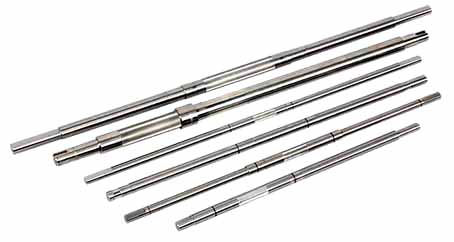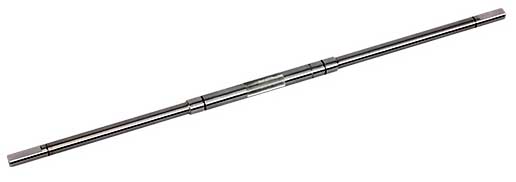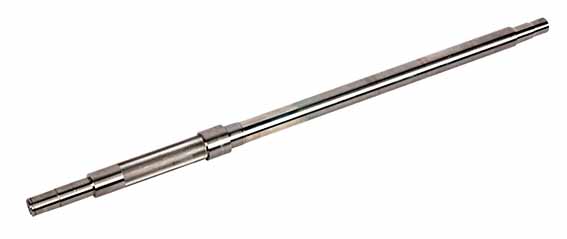What is a slender shaft for lathe machining?
The elongated shaft refers to the shaft whose length to diameter ratio is greater than 25 (ie L/D>25).
Such as the lead screw, smooth rod, etc.. sur le tour. Due to the poor rigidity of the slender shaft, it is easily deformed due to the effect and influence of the turning force, cutting heat and vibration during turning. Machining errors such as straightness and concentricity appear. It is difficult to meet the technical requirements such as geometric tolerances and surface quality on the drawing, which makes turning processing very difficult. The larger the L/d value, the more difficult the turning process.

Technology for turning slender shafts
In the CNC machining process, it is affected by multiple factors such as machine tools and turning tools. The workpiece is prone to defects such as curved waist drum shape, polygonal shape, slub shape and so on. Especially in the grinding process, the general size is poor, and the surface roughness is required to be higher. En outre, because the workpiece generally requires heat treatment requirements such as quenching and tempering during grinding, the cutting heat during grinding is more likely to cause deformation of the workpiece and so on. In order to prevent the bending deformation during processing, the technicians of our factory take measures from the aspects of fixtures, machine tools, process methods, operation techniques, turning tools and cutting volume.

Concentricity and perpendicularity of turning slender shaft
Improved method of turning
When CNC turning a slender shaft, the clamping method of clamping one end and tightening one end is adopted. When clamping the workpiece with a chuck, an open wind wire ring is inserted between the jaw and the workpiece to reduce the axial angle length between the workpiece and the jaw. An elastic center is used for clamping on the tailstock, so that when the workpiece is stretched by the cutting heat, the thimble can expand and contract in the axial direction to compensate for the working pavilion shape and reduce the bending of the workpiece.
Follow the knife rest
The follower is an auxiliary device of the lathe. It is used to support the workpiece near the cutting point of the tool and move longitudinally with the carriage slide. The supporting piece where the tool rest is in contact with the workpiece is generally made of wear-resistant ductile iron or bronze. The arc of the supporting claw should be ground and matched with the outer circle after rough turning to avoid scratching the workpiece. The follower tool holder can offset the influence of the radial cutting component force and the weight of the workpiece during machining, thereby reducing cutting vibration and workpiece deformation. But it must be carefully adjusted to keep the center of the follower tool holder consistent with the center of the thimble of the machine tool.

Difficulty of CNC machining of slender shaft
Angle of turning tool
In order to reduce the radial cutting force, a larger entering angle should be selected; The rake face should be ground with a chipbreaker R=1.5-3mm, and the rake angle is generally γ0=150-300; The cutting edge angle λs takes a positive value to make the chips flow to the surface to be machined; The surface roughness value of the turning tool should be small, and the cutting edge should always be kept sharp.
CNC turning volume
When turning a slender shaft, the cutting amount should be appropriately reduced compared to ordinary shaft parts. Rough turning with a cemented carbide turning tool, the cutting amount can be as follows
| Workpiece diameter /mm | 20 | 25 | 30 | 35 | 40 |
| Workpiece length /mm | 1000-2000 | 1000-2500 | 10003-000 | 1000-3500 | 1000-4000 |
| Feed/mm.r | 0.3-0.5 | 0.35—0.4 | 0.4-0.45 | 0.4 | 0.4 |
| Cutting depth ap/mm | 1.5-3 | 1.5-3 | 2-3 | 2-3 | 2.5-3 |
| Cutting speed v/mm.s | 40-80 | 40-80 | 50-100 | 50-100 | 50-100 |
For fine turning, use a carbide turning tool to turn a slender shaft of φ20, φ40mm, and a length of 1000-1500mm. Optional f=0.15-0.25mm/r, ap=0.2-0.5mm, v=60-100m/s
3. Technical parameters of the slender shaft
| produit | Pièces de machines |
| certificat | ISO 9001,ISO/TS16949 |
| matériel | Acier allié, Acier Carbone, acier inoxydable, fer inoxydable |
| Traitement de surface | Oxydation, noircissement, galvanoplastie, polissage, traitement noir mat, sablage |
| Test de l'Équipement | projecteur, Testeur de rugosité, Instrument de mesure du faux-rond du pas de filetage, Étriers, micromètre, Micromètre à levier, Pieds à coulisse à micro-fils, Jauges, Testeur de dureté Rockwell, Testeur de dureté Webster, Jauge de diamètre, Centre d'essais d'engrenages, Testeur de rondeur, testeur de déflexion, Ne transmettre que les règles, Haut profil, Jauge de filetage, etc.. |
| Équipement de traitement | Centre d'usinage CNC, tour CNC, Fraiseuse CNC, Meuleuses cylindriques intérieures et extérieures, Broyeur sans centre , Meuleuse CNC, Tour automatique, broyeur, Machine à estamper, Machine de soudage, Perceuse, Machine à tarauder, Coupe de fil, Machine à rouler les fils, Machine à tailler les engrenages CNC, Machine de superfinition de surfaces, etc.. |
| Format de dessin | PDF, dwg, GOUJAT,JPG, Œuvres solides |
| Capacité de production | 100,000 pièces/mois |
| Gamme de taille | DEPUIS: Φ4mm-Φ50mm, longueur ≤700mm |
| Champ d'application | Équipement de fitness, automobiles, climatiseurs, appareils ménagers, appareils de bureau, équipement médical, etc.. |
| emballer | Sac plastique + carton + (palette), sac plastique + boite en bois, selon les exigences du client |
| Délai de livraison | Échantillon: 10-15 jours; Lot: Selon la quantité commandée |
- Précision d'usinage de l'arbre
| Rondeur | 0.001mm |
| Rugosité | Ra0,04 |
| Platitude | 0.001mm |
| dureté | HRC/HV |
| Précision | Niveau 6 |
| tolérance | +/-0.001mm |
- Avantages du fabricant d'arbres
① Traitement personnalisé précis des dessins et des échantillons;
② Une entreprise de fabrication d'arbres, avec plus de 20 années d'expérience dans l'usinage d'arbres de précision, et un support technique solide. Équipement de traitement avancé, équipement d'inspection complet et une solide équipe d'inspection logistique;
③ 100% inspection d'usine, assurance qualité;
④ Strong productivity and short processing cycle.6. Usinage de matériaux d'arbre courants
| acier inoxydable | SS201,301,304,SS303,SS304,SS316 |
| Acier Carbone | 20#,35#,45# |
| Fer inoxydable | 1Cr17,2Cr13,3Cr13,6Cr13,7Cr17 |
| Autres aciers alliés couramment utilisés | 35CrMo,20Cr,40Cr,40CrMo,42CrMo,20CrMnTi,20CrMMnMo |
- Traitement de surface
| acier inoxydable | Autres matériaux en acier |
| polissage | Noircissement |
| placage | Galvanisé |
| Sablage | Plaqué nickel |
| Gravure laser | Chromage |
| Cémentation | |
| Traitement thermique |
- Normes d'inspection strictes
① Une équipe QC solide;
② Inspection à l'arrivée des matières premières;
③ Première inspection, inspection de patrouille, inspection aléatoire;
④ 100% inspection d'usine.
 English
English العربية
العربية 中文(漢字)
中文(漢字) Čeština
Čeština Dansk
Dansk Nederlands
Nederlands Suomi
Suomi Français
Français Deutsch
Deutsch Italiano
Italiano 日本語
日本語 ಕನ್ನಡ
ಕನ್ನಡ 한국어
한국어 Português
Português Русский
Русский Slovenčina
Slovenčina Español
Español Svenska
Svenska Türkçe
Türkçe

